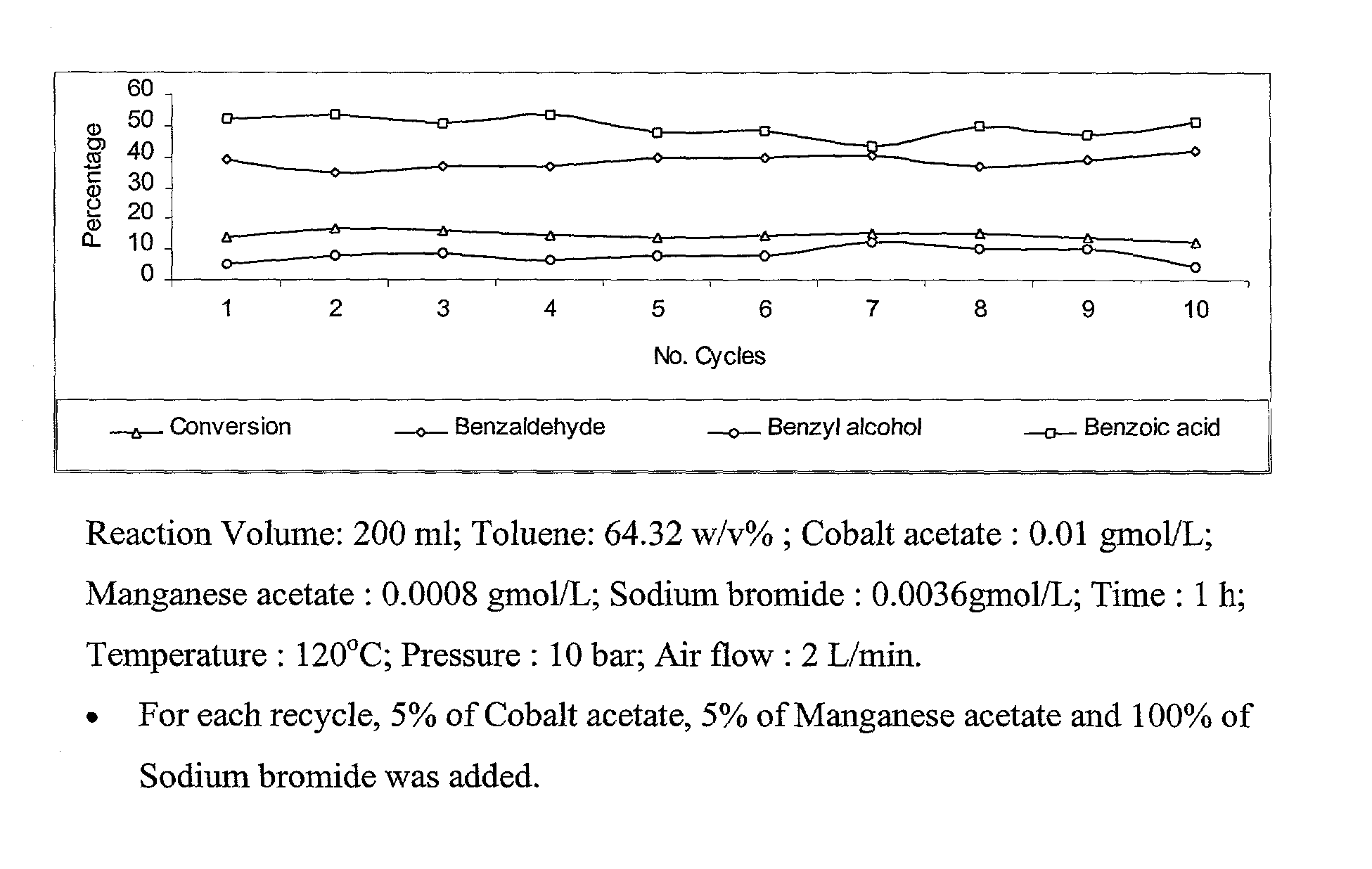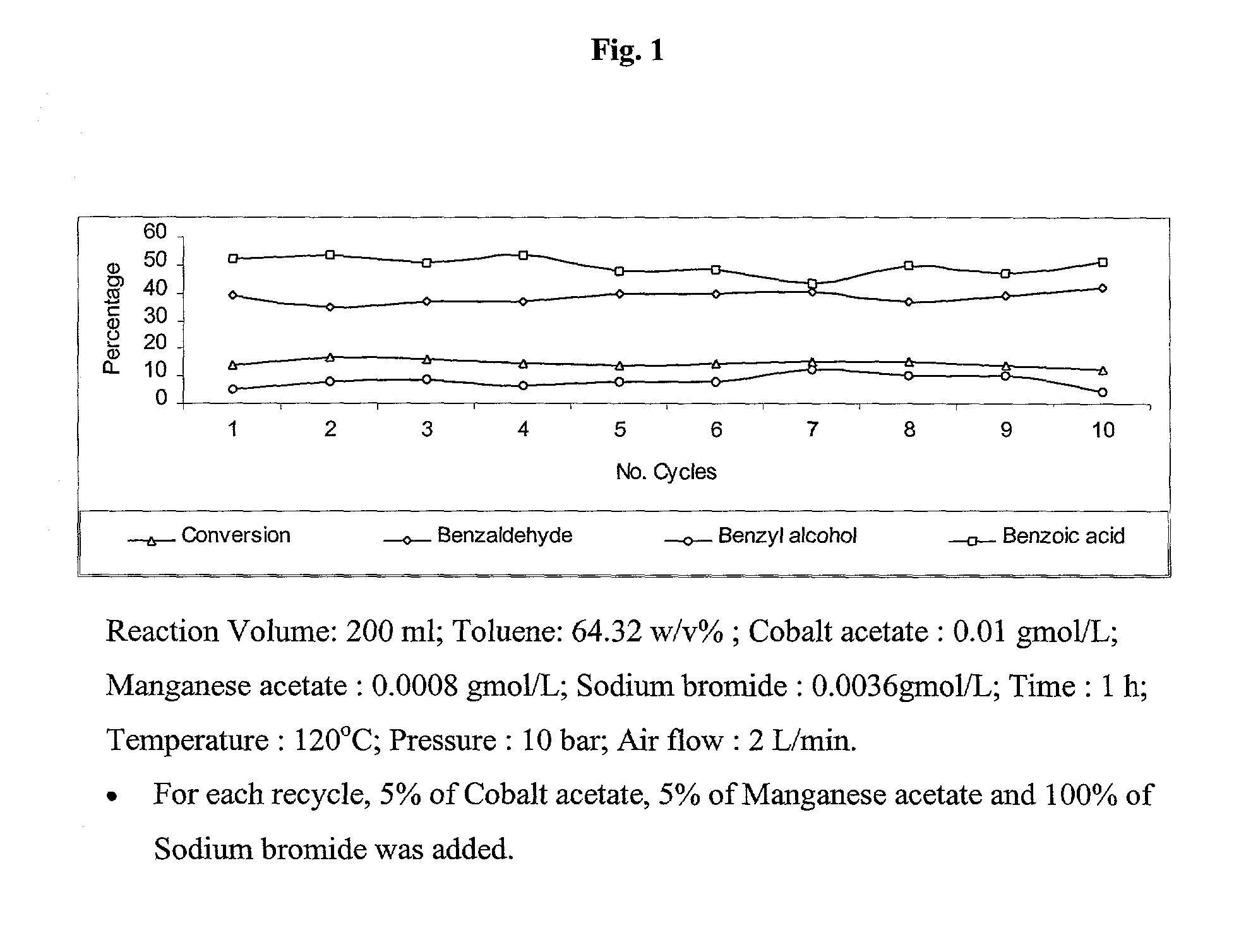Selective liquid phase air oxidation of toluene catalysed by composite catalytic system
a composite catalytic system and liquid phase air technology, applied in the preparation of carbonyl compounds, carboxylic compounds, oxygen-containing compounds, etc., can solve the problems of large excess of effluent generation, benzaldehyde produced does not meet food grade specifications, and the effect of large excess
- Summary
- Abstract
- Description
- Claims
- Application Information
AI Technical Summary
Benefits of technology
Problems solved by technology
Method used
Image
Examples
example 1
[0054] Buchi glass autoclave of 500 ml capacity equipped with a gas connecting tube, stirrer, temperature indicator and pressure gauge was deployed. The following materials were taken in the reaction vessel: 225 ml toluene, 75 ml of acetic acid, and 1.50 g of cobalt acetate, 0.09 g of manganese acetate.4 water salt, 2.7 g of zinc bromide. After flushing with air three times, the solution was heated slowly up to 110.degree. C. while stirring the reaction mixture. After system attained a constant temperature of 110.degree. C., it was pressurised with air to 10 bar with 2 L / min out flow. After 1:15 hrs, the reaction mixture was taken out. Gas chromatographic and titrimetric analysis on the product indicates conversion of 14.04% with selectivity of 42.3% benzaldehyde, 4.98% benzyl alcohol and 52.72% benzoic acid.
example 2
[0055] Buchi glass autoclave of 250 ml capacity equipped with a gas connecting tube, stirrer, temperature indicator and pressure gauge was deployed. The following materials were taken in the reaction vessel: 150 ml of toluene, 50 ml of acetic acid, and 0.5 g of cobalt acetate 4 water salt, 0.04 g of manganese acetate.4 water salt, 0.66 g of zinc bromide. After flushing with air three times, the solution was heated slowly up to 110.degree. C. while stirring the reaction mixture. After system attained a constant temperature of 110.degree. C., it was pressurised with air to 10 bar with 2 L / min out flow. After 1:15 hrs, the reaction mixture was taken out. Gas chromatographic and titrimetric analysis on the product indicates conversion of 15.78 % with selectivity of 36.59 % benzaldehyde, 6.04% benzyl alcohol and 57.37% benzoic acid.
example 3
[0056] Buchi glass autoclave of 250 ml capacity equipped with a gas connecting tube, stirrer, temperature indicator and pressure gauge was deployed. The following materials were taken in the reaction vessel: 150 ml of toluene, 50 ml of acetic acid, and 0.5 g of cobalt acetate.4 water salt, 0.04 g of manganese acetate.4 water salt, 0.106 g of sodium bromide, 0.314 g of sodium chloride. After flushing with air three times, the solution was heated slowly up to 110.degree. C. while stirring the reaction mixture. After system attained a constant temperature of 110.degree. C., it was pressurised with air to 10 bar with 2 L / min out flow. After 1:15 hrs, the reaction mixture was taken out. Gas chromatographic and titrimetric analysis on the product indicates conversion of 14.34 % with selectivity of 42.61% benzaldehyde, 3.83% benzyl alcohol and 53.56% benzoic acid.
PUM
| Property | Measurement | Unit |
|---|---|---|
| pressure | aaaaa | aaaaa |
| temperature | aaaaa | aaaaa |
| residence time | aaaaa | aaaaa |
Abstract
Description
Claims
Application Information
 Login to View More
Login to View More - R&D
- Intellectual Property
- Life Sciences
- Materials
- Tech Scout
- Unparalleled Data Quality
- Higher Quality Content
- 60% Fewer Hallucinations
Browse by: Latest US Patents, China's latest patents, Technical Efficacy Thesaurus, Application Domain, Technology Topic, Popular Technical Reports.
© 2025 PatSnap. All rights reserved.Legal|Privacy policy|Modern Slavery Act Transparency Statement|Sitemap|About US| Contact US: help@patsnap.com


